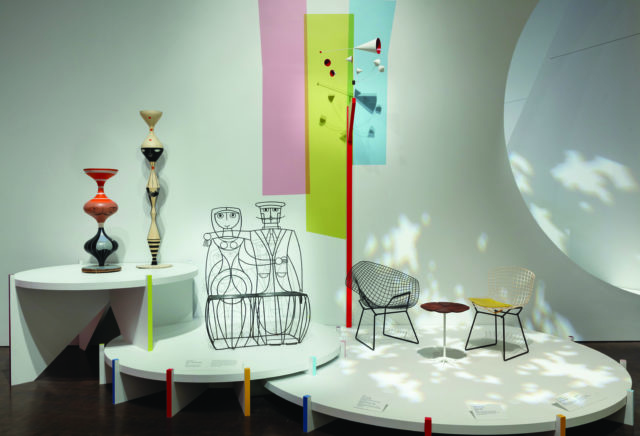
America was reborn after World War II. Industries that thrived producing goods during and for the war sought new means of production. Everyday Americans were refocusing on the home and the baby boom was in full swing. Hope bloomed, for a time, and Americans savored the breath of fresh air.
During this fruitful time, designers of all sorts, in textiles, furniture, architecture, toy-making and more, imbued the American landscape with playfulness and whimsy. It’s this trend that is the spotlight of the Denver Art Museum’s latest exhibit Serious Play, showing through Aug. 25. Serious Play traces the styles that shaped childhood, home life and the work place in mid-century America.
“This was an era just after the war. There was this younger population that wasn’t interested in their parent’s furniture,” says Darrin Alfred, curator of architecture and design at DAM. “They wanted something that was new and modern. Also, because of the rationing that happened and the scaling back of production in this realm, there was this interest for whimsical objects, for bright colors, for really fun patterns.”
Co-curated by Alfred and Monica Obniski, curator of 20th and 21st century design at the Milwaukee Art Museum, the exhibit showcases items like odd-shaped sofas, quirky wall hangings, fun-shaped clocks and knickknacks used for personal flair such as folk art and travel souvenirs. This was an age when personality was fostered, and to combat the mass consumerism of the time, Alfred says, people were encouraged to make their spaces unique.
Branching off from the American home, Serious Play examines how other facets of life were developing, too. As America fought for superiority, there was a push for children to become more creative. The show displays educational, do-it-yourself and building toys that were heavily touted at the time.
Corporations also wanted to capitalize off this prevalent spirit and infused their workspaces, products and advertisements with bold freshness. Many had to redefine their business, such as aluminum company Alcoa. During wartime, Alcoa was using its resources to support the war efforts; afterward it had to figure out how to remarket for consumers.
“[Alcoa was] really interested in showing designers and the broader American public how aluminum could be this great product or material for the future,” Alfred says. “Not just for the pots and pans in your home or the aluminum furniture in your backyard. It could be really this very innovative and exciting material to use in all types of design.”
Looking at design is an effective way to capture the feeling of an era. It is one of the most relatable art forms because, for example, everyone deals with furniture on a daily basis. That fact has had many people asking Alfred why furniture would be featured in an art museum.
“There is this creativity and personal expression involved. Just as a painting can have a thousand different outcomes, so can designing a chair,” he says. “And even though [with designing a chair] there’s a problem behind it, the solution can be so varied that there is this art aspect to it.
“Many designers aren’t interested in solving a design problem,” he continues. “They’re more interested in using the form of a piece of furniture or a chair to express an idea or a thought whether that be social, cultural or political.”
There’s a blurred line between art and function that is prominent in Serious Play. Many pieces of furniture are intriguing or beautiful to look at but might not be the coziest couch for your living room. This notion is where the theme of play emerges and shows its value.
Alfred acknowledges that while play may have a negative connotation as something only for children, it was an abundant approach for designers at the time. It encourages forward-thinking, exploration and originality.
“The idea of play can be approaching something without a specific solution in mind,” he says. “To be able to experiment and innovate you have to open your mind to all sorts of opportunities. Approaching these projects from a playful state of mind allows you to be a little bit more open-ended about what the solution could be, can be or would be.”
While the exhibit is not explicit in its parallels, Alfred sees many similarities between mid-century America and now. Cultures frequently have to revamp when outdated ideas reach their peak. In today’s world people are striving to modernize their lifestyles, corporations are creating more visionary work spaces, industries are fighting to keep up with the breakneck market changes and the dismal political arena has many clamoring for whimsy.
Fresh ideas breed hope. After hard times, a community places faith in the future. It’s an idea we can utilize: Play today for a better tomorrow.
ON THE BILL: ‘Serious Play’. Denver Art Museum, 100 W. 14th Ave. Parkway, Denver. Through Aug. 25.














